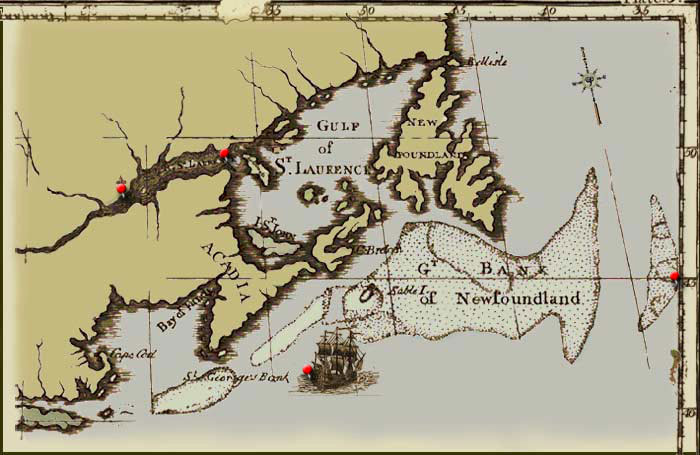Oh, Kanata, First Contact.

Newfoundland to New-York In order to avoid the Gulph Stream
The Grand Banks.
The rich fisheries of the Grand Banks off Newfoundland were frequented by French sailors as early as 1506. Warm currents from the Gulf Stream enabled the growth of nutrients that attracted a bounty of fish. Some claimed one merely had to drop a basket over the side of the boat to harvest them, though in truth they caught the Cod with a hook and line from their ships.

Normans, Bretons and Basque fishermen routinely made one or two trips a year processing their catch on board with salt. This form of preservation was facilitated by their easy access to salt and gave them a bit of an edge over other nations in transporting their catch home. Later, short term settlements were established to dry the fish to preserve it for the journey. While waiting for the fish to dry they often traded goods for furs with the native population.
The wealth of the Grand Banks as a food resource was a key component in France's desire to establish a foothold in the New World.
Jacques Cartier.

commemorative stamps
Jacques Cartier of Saint-Malo, Bretagne made three trips across the Atlantic beginning in 1534. Like other adventurers of the day, he sought fabled riches and a route to Asia. Cartier was the first European to sail up la Grande Rivière mapping it as went. The Saint-Lawrence Iroquois word "kanata", which actually referred to a village or settlement, was used by him to describe the lands he claimed for France and thus he gave Canada its name.
He reached the Iroquois settlement of Stadacona during his second foray in 1535. At the much larger village of Hochelaga he was stopped from sailing further west by the rapids. On his third visit in 1541 he established the short-lived colony Charlesbourg-Royal. But the jewels he found and brought back to France were worthless quartz and pyrite leading to the expression faux comme les diamants du Canada.
Samuel de Champlain.
Honored as the Father of New France, Samuel de Champlain's first trip to Canada was in 1603. He came from a family of mariners, and is credited with producing a reliable map of the Canadian coastline. Under his supervision settlers established successful colonies, including the Habitation in 1608 which was the precursor to Québec City. It served as a base for the growing fur trade industry. Some researchers claim our ancestor Pierre Godfrey accompanied him on at least one of his trips, acting as an interpreter.

Le sieur de Champlain shown firing d'arquebuse, or musket.
Champlain wrote books, maps, and drawings and was highly regarded in the colony. Yet one action he took in 1609 had a far reaching impact over the next century. By allying with neighboring native tribes, the Huron or Wendat, the Algonquin, and the Montagnais, he, and thus the French, became enemies of the Iroquois to the south. In the coming decades they were to align with the British as the European nations struggled for control in the New World. Champlain died in December 1635.
The First of Our Ancestors to Settle in Canada.
Our ancestors began arriving in the next decade or so. The first to settle in New France came prior to 1650. They were Jean-Baptiste Bourgery and his wife Marie Gendre; Étienne Vien, his wife Marie Denot, and their daughter Marie Vien; and Léonard Leblanc who married Marie Riton in Beauport, Québec in 1650. Their daughter, Thérèse Leblanc, was born in 1651, and she was the first of our line born in the New World.
- National Archives, map image ct000136.jpg, NOTE: The Gulf Stream was not identified as such in Champlain's time, this map has been altered from the original to better reflect the topic covered
- Henry Bohn, London, 1854, Haddock and Cod, author's collection
- Postal Stamp image from Wikimedia
- Genealogie de David Allart, https://gw.geneanet.org/
- Morison, Samuel Eliot, Samuel de Champlain, Father of New France, Boston: Atlantic Monthly Press & Little, Brown & Co, 1972
- Deffaite des Yroquois au Lac de Champlain from Les voyages du sieur de Champlain Xaintongeois..., Paris, Jean Berjon, 1613 at https://www.gutenberg.org/files/17258/17258-h/images 3_20g.png
